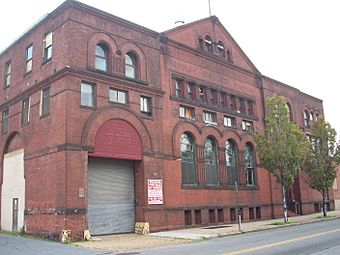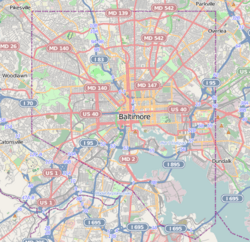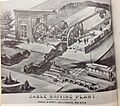Hendler Creamery facts for kids
Quick facts for kids |
|
|
Hendler Creamery
|
|

Hendler Creamery in 2011
|
|
| Location | 1100 E. Baltimore St. & 1107 E. Fayette St., Baltimore, Maryland |
|---|---|
| Area | 1.5 acres (0.61 ha) |
| Built | 1892 |
| Architect | Jackson C. Gott |
| Architectural style | Romanesque, Early Commercial |
| NRHP reference No. | 07001032 |
| Added to NRHP | December 20, 2007 |
The Hendler Creamery was a famous building in Baltimore, Maryland. It was important for three main reasons: how people traveled, entertainment, and making things. First, it was a powerhouse for cable cars, which were like early trolleys. Then, it became a theater. Finally, it was a very popular ice cream factory for many years.
The building was thought to be strong in 2007. But in 2012, a company bought it and promised to fix it up. Instead, they took off the roof, which led to the building being completely torn down. This historic building was demolished in September 2024. It became an example of "demolition by neglect", which means a building is allowed to fall apart on purpose so it can be torn down.
Contents
The Hendler Creamery Story
Building a Landmark
The original building was designed by a Baltimore architect named Jackson C. Gott. It was built in 1892 and had three stories made of brick. The style was called Richardsonian Romanesque, which means it had big, round arches. The front of the building on East Baltimore Street had four huge arched openings.
The The Baltimore Sun newspaper wrote in 1892 that it would be "one of the most prominent structures" in that part of the city. Later, the Hendler Creamery added more parts to the building in 1915-20 and 1949.
Cable Car Powerhouse Days
The building first opened in 1892 as a powerhouse for the Baltimore City Passenger Railway Company. It only worked for six years, until 1898. This building was a big part of Baltimore's transportation history. Cable cars were a new way to travel, replacing horse-drawn carriages.
The powerhouse used huge steam engines to pull a continuous loop of cable. This cable moved the cars at about 11 miles per hour. This cable car line was called the Red Line. It ran from North Avenue, down Gay Street, and then along East Baltimore Street to Patterson Park.
In 1898, electric-powered cars with overhead lines started to replace cable cars. They were cheaper and faster. The cables were removed, but the underground parts were often just covered up because they were too expensive to dig out.
After the cable cars stopped, the building was used for a while by the U.S. Navy (Maryland) Naval Reserves as a drill room.
From Powerhouse to Stage: Yiddish Theater
After the cable cars were gone, the Hendler Creamery building became a place for performances. A man named James Lawrence Kernan turned it into a theater. He added a second floor with an auditorium and dressing rooms. He called it the Convention Hall Theater.
From 1903 to 1912, it was mainly a Yiddish theater. This was important for the many Jewish immigrants living in the city. Some of Baltimore's first movies were also shown here. This theater helped shape Baltimore's early 20th-century performing arts scene, which included plays, movies, and other shows.
The Famous Hendler Ice Cream Factory
The building's longest and most famous history began in 1912. The Hendler Ice Cream Company bought it and turned it into the country's first fully automated ice cream factory.
Hendler's made one of Baltimore's favorite ice cream brands. It also played a big role in the national ice cream business. Over 50 years, many new ideas were created here. These included new ways to package ice cream and methods for making it smoother and freezing it faster.
The building next door, built in the 1920s, was important too. It helped create one of the nation's first delivery systems for ice cream using refrigerated trucks. At its busiest, Hendler's ice cream was sold in over 400 stores across Maryland. They made vanilla ice cream almost every day, along with chocolate and strawberry. They even made special flavors like ginger, peppermint, and a tomato sorbet for a hotel! For Christmas, they made eggnog ice cream with real rum.
The creamery closed its doors in the 1970s.
Why Hendler Creamery Was Important
The Hendler building was the only one of Baltimore's six cable-car powerhouses to be added to the National Register of Historic Places in 2007. This was because of its important role in three parts of Baltimore's history: transportation, performing arts, and industry.
The area around the creamery was home to many Eastern European and Jewish families. The Yiddish Theater and the creamery itself are part of Baltimore's Jewish history. The nearby Jewish Museum of Maryland has many items from the Hendler Company and family. The factory was the first fully automated ice cream factory in the country and made one of Maryland's most popular ice cream brands.
Demolition by Neglect: A Sad Story
In 2007, experts said the building was structurally sound, meaning it was strong. Five years later, a company bought it, saying they would fix it up. But that never happened. Instead, the company let the building fall apart. They even removed the roof in 2023, which allowed rain and weather to damage the inside.
This made it easier for city officials to approve its demolition, even though many people protested that the building could be saved. This situation became a famous example of "demolition by neglect". This is when a historic building is allowed to decay on purpose so it can be torn down.
A non-profit group bought the building from the developer. They were allowed to tear it down completely. The demolition finished in September 2024. The land will become a private park. This sad story shows how important it is to protect historic buildings.
Gallery









